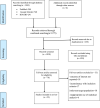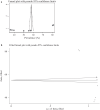Knowledge and practice of essential newborn care and associated factors among women in Ethiopia: systematic review and meta-analysis
- PMID: 35927762
- PMCID: PMC9351089
- DOI: 10.1186/s12978-022-01480-0
Knowledge and practice of essential newborn care and associated factors among women in Ethiopia: systematic review and meta-analysis
Abstract
Background: In developing countries, including Ethiopia the risk of neonatal death can be easily prevented and avoided by implementing essential newborn care with simple, low cost, and a short period time immediately after delivery. However, the problem is still persisting due to lack of adequate maternal and newborn care practice. Hence, this review aimed to estimate the pooled prevalence of women's knowledge and practice of essential newborn care and its associated factors in Ethiopia using systematic review and meta-analysis.
Method: An intensive literature search was performed from PubMed, Google Scholar, EMBASE, HINARI, Scopus, and Web of Sciences from April 1-30, 2021. Data were extracted by using a pre-tested and standardized data extraction format. The data were analyzed by using STATA 14 statistical software. I2 tests assessed heterogeneity across the included studies. A random-effect model was used to estimate the pooled prevalence of knowledge and practice of essential newborn care.
Results: From 1275 identified studies, 25 articles were included. The national pooled prevalence of essential newborn care knowledge and practice among women was 55.05% and 41.49% respectively. Secondary education (AOR = 2.75, 95% CI 1.62, 4.66), multiparity (AOR = 2.14, 95% CI 1.41, 3.26), antenatal care (AOR = 2.94; 95% CI 2.03, 4.26), and postnatal follow-up (AOR = 1.64, 95% CI 1.20, 2.23) were significantly associated with knowledge level whereas; primary education (AOR = 7.08, 95% CI 4.79, 10.47), urban residency (AOR = 2.22, 95% CI 1.65, 3.00), attending monthly meetings (AOR = 2.07, 95% CI 1.64, 2.62), antenatal care (AOR = 2.89, 95% CI 1.97, 4.26), advised during delivery (AOR = 2.54, 95% CI 1.80, 3.59), postnatal follow-up (AOR = 7.08, 95% CI 4.79, 10.47) and knowledge (AOR = 2.93; 95% CI 1.81, 4.75) were statistically significant with essential newborn practice.
Conclusions: The current systematic review and meta-analysis findings reported that the level of knowledge and practice of essential newborn care among Ethiopian women was low. Therefore, improvement of essential newborn through the provision of community-based awareness creation forum, improving antenatal and postnatal care follow up, education on essential newborn care to all pregnant and postnatal women are very important. Trial registration Prospero registration: CRD 42021251521.
Keywords: Essential; Ethiopia; Knowledge; Newborn; Practice.
Plain language summary
Essential newborn care (ENC) is a single most cost-effective intervention to reduce neonatal mortality and morbidity both in developed and developing countries. An intensive electronic search from PubMed, Google Scholar, EMBASE, HINAR, Scopus, and Web of Sciences were performed to identify the primary studies. In this meta-analysis a total of 25 articles were included to estimate the polled prevalence of ENC knowledge and practice among Ethiopian women. Accordingly, the national pooled prevalence of ENC knowledge and practice among women was 55.05% and 41.49% respectively. In the current systematic review and meta-analysis, Secondary education, multiparity, antenatal care, and postnatal follow-up were significantly associated with knowledge level whereas; primary education, urban residency, attending monthly meetings, antenatal care, advised during delivery, postnatal follow-up and knowledge on ENC were found to be statistically significant with essential newborn practice. As per finding the knowledge and practice regarding essential newborn care among women in Ethiopian was significantly low. Hence, improvement of essential newborn through the provision of community-based awareness creation forum, improving antenatal and postnatal care follow up, education on essential newborn care to all pregnant and postnatal women are very important.
© 2022. The Author(s).
Conflict of interest statement
The authors declare that there is no competing interests.
Figures













Similar articles
-
Postpartum intrauterine contraceptive device use and its associated factors in Ethiopia: systematic review and meta-analysis.Reprod Health. 2021 Nov 13;18(1):225. doi: 10.1186/s12978-021-01273-x. Reprod Health. 2021. PMID: 34774058 Free PMC article.
-
Knowledge and utilisation of preconception care and associated factors among women in Ethiopia: systematic review and meta-analysis.Reprod Health. 2021 Apr 15;18(1):78. doi: 10.1186/s12978-021-01132-9. Reprod Health. 2021. PMID: 33858438 Free PMC article.
-
Magnitude of postpartum hemorrhage and associated factors among women who gave birth in Ethiopia: a systematic review and meta-analysis.Reprod Health. 2022 Sep 21;19(1):194. doi: 10.1186/s12978-022-01498-4. Reprod Health. 2022. PMID: 36131345 Free PMC article.
-
Intimate partner violence among women of reproductive age during the COVID-19 pandemic in Ethiopia: a systematic review and meta-analysis.BMJ Public Health. 2025 Feb 4;3(1):e001161. doi: 10.1136/bmjph-2024-001161. eCollection 2025. BMJ Public Health. 2025. PMID: 40017976 Free PMC article.
-
Suicidal ideation and its associated factors among pregnant and post-partum women in Ethiopia, a systematic review and meta-analysis, 2025.BMC Psychiatry. 2025 Jul 1;25(1):616. doi: 10.1186/s12888-025-07093-8. BMC Psychiatry. 2025. PMID: 40598047 Free PMC article.
Cited by
-
Assessing postnatal care for newborns in Sub-Saharan Africa: A multinational analysis.PLoS One. 2024 Feb 15;19(2):e0298459. doi: 10.1371/journal.pone.0298459. eCollection 2024. PLoS One. 2024. PMID: 38359030 Free PMC article.
-
Early newborn bathing practice and its determinants among postpartum women in Ethiopia: a systematic review and meta-analysis.BMC Pregnancy Childbirth. 2024 Jan 27;24(1):87. doi: 10.1186/s12884-024-06280-x. BMC Pregnancy Childbirth. 2024. PMID: 38281013 Free PMC article.
-
Measuring socioeconomic inequalities in postnatal health checks for newborns in Ethiopia: a decomposition analysis.Front Public Health. 2024 Jun 5;12:1384729. doi: 10.3389/fpubh.2024.1384729. eCollection 2024. Front Public Health. 2024. PMID: 38903590 Free PMC article.
-
Determinants of essential newborn care practices among mothers. A descriptive cross-sectional study in a peri-urban community, Ghana.Reprod Health. 2025 Feb 20;22(1):27. doi: 10.1186/s12978-025-01968-5. Reprod Health. 2025. PMID: 39979988 Free PMC article.
-
Effect of Maternal Pregnancy Intention on Neonatal and Infant Healthcare Across the Continuum of Care in Ethiopia: A National Longitudinal Study Using Propensity Score Methods.Child Care Health Dev. 2025 Sep;51(5):e70151. doi: 10.1111/cch.70151. Child Care Health Dev. 2025. PMID: 40760995 Free PMC article.
References
-
- Narayanan I, Rose M, Cordero D, Faillace S, Sanghvi T. The components of essential newborn care. Published by the basics support for institutionalizing child survival project (BASICS II) for the United States Agency for International Development. Arlington, Virginia, June 2004.
-
- United Nations Development Programme (UNDP) Measuring human development: a primer. New York: UNDP; 2007.
-
- You D, Hug L, Ejdemyr S, Idele P, Hogan D, Mathers C, et al. Global, regional, and national levels and trends in under-5 mortality between 1990 and 2015, with scenario-based projections to 2030: a systematic analysis by the UN inter-agency group for child mortality estimation. Lancet. 2015;386(10010):2275–2286. doi: 10.1016/S0140-6736(15)00120-8. - DOI - PubMed
-
- Médecins Sans Frontières. Essential obstetric and newborn care. 2019. ISBN 978-2-37585-039-8.
Publication types
MeSH terms
LinkOut - more resources
Full Text Sources
Medical
Research Materials
Miscellaneous

